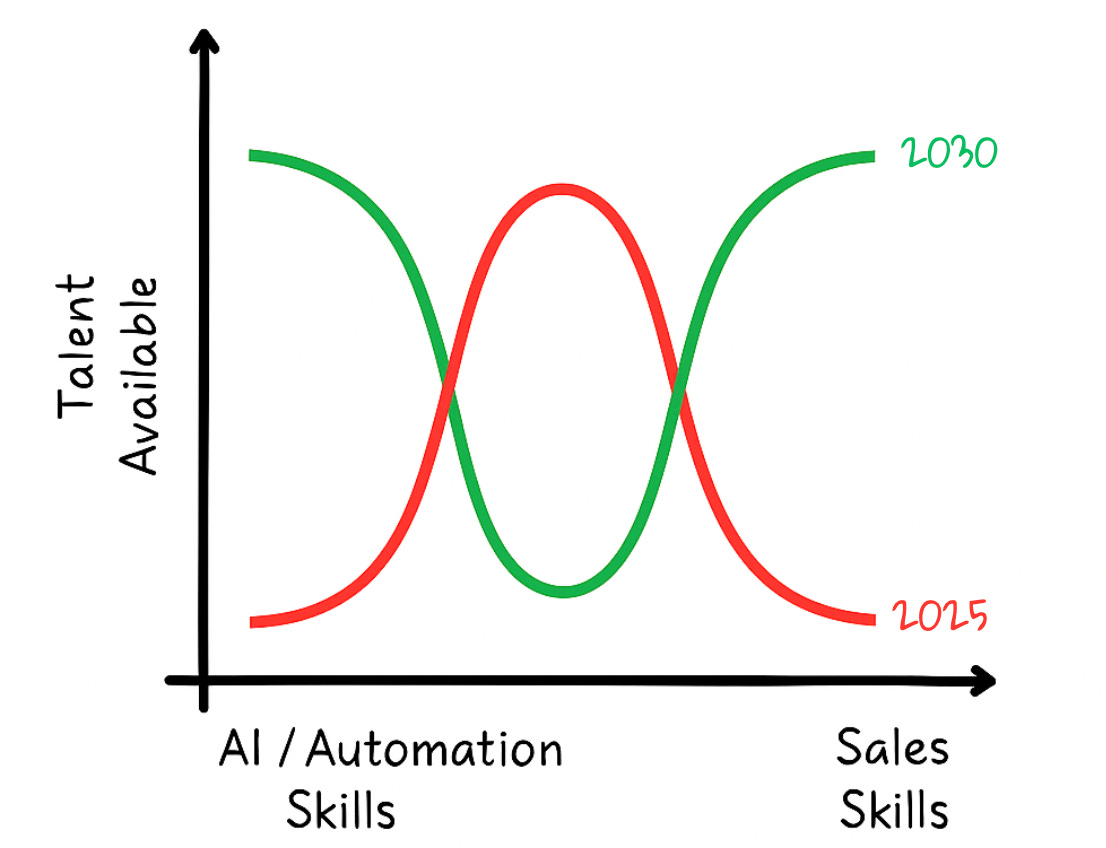The AI War in Sales: The Moat of Talent Is Rising
Automation created efficiency, AI is forcing us to decide where humans still add value.
Five years ago, the trend was automation.
Leadership teams everywhere debated what to streamline next: outbound emails, first contact, scheduling links, customer success handoffs, blogs, and dynamic FAQ pages. The principle was clear. If a task was repetitive and the buyer did not push back, we automated it. Faster workflows meant more meetings. More meetings meant more pipeline. At least, that was the theory.
What we underestimated was the cost. Not the financial one, but the human toll.
In down-market segments, we leaned into automation and volume. In the upmarket, we pushed toward sales craft and skill. We trained a generation of sales reps to operate in high-velocity machines without ever teaching them how to sell. Tools improved. Talent declined. The idea of “more” won the argument because it was easy to justify in planning meetings and dashboards.
The buyer experience suffered first.
As every sales organisation followed the same playbook, inboxes became unusable. Open rates collapsed. Conversion rates dropped. Not because buyers had no need, but because they had no patience left for mediocre sellers. Every rep sounded the same. The moat between the sales rep and the customer kept rising.
Automation did its job. But it also erased the sales craft for an entire generation of sellers.
Over the past year, the next wave has arrived, and it will hit like a tsunami. This is no longer about tools or hacks. This is a paradigm shift. AI is not just focused on improving efficiency. It is now delivering perceived quality at scale. The line between human and machine is blurring faster than most realise.
Just last week, I called the service department of my car dealer. We discussed how fast I needed the repair, the issue history, the type of car, and the best time for an appointment. For the whole call I had spoken entirely with an AI bot. It was not just passable. It was better than any conversation I had previously had with their staff.
This is not a curiosity. It is a warning shot.
If I were the owner of that car service garage, I would make the same decision. I would replace the human phone operator with the AI version. It delivered faster service, better consistency, and a more professional experience.
So the question for us as revenue leaders becomes this: where do humans actually belong in the sales process?
Certainly not in scale. Not in outbound. Not in efficiency. Humans belong where automation breaks down. In complexity, emotion, judgment, and nuance. In the moments where taste matters.
Where experience and instinct outperform the playbook. Where the deal is not closed by the number of touches, but by navigating politics and helping people feel seen.
Cal Newport calls on this as an idea in “Slow Productivity.” The belief that doing fewer things does not mean achieving less. In fact, he argues the opposite. But in sales, we often see the inverse. We as leaders ask for a set number of emails per day, per rep. The result? Reps use ChatGPT to produce a stream of slightly tweaked, tone-deaf messages. It creates the illusion of productivity. Or what Newport might call pseudo productivity.
That is the real risk.
We are measuring the wrong things and still expecting the right outcomes.
If you measure speed, you will get speed.
If you reward volume, you will get volume.
But speed without clarity is just noise. And volume without purpose is spam.
Here is my prediction.
We are heading toward a split in sales talent. On one side, we will see highly technical operators who master AI tooling, automate workflows, and build scalable systems for low-friction buying experiences. On the other side, we will see deeply experienced professionals who understand the emotional and strategic complexity of enterprise deals. They will know how to manage risk, navigate internal politics, and shape consensus across multiple stakeholders. Everyone else, the average rep, armed with AI but lacking judgment, will become obsolete.
And that should concern every revenue leader reading this. Because our job is no longer just about hiring and enabling talent.
We must redesign our sales organisations around this new reality.
So we must ask ourselves:
How do we develop talent that can sell where AI fails?
How do we build systems where humans are used intentionally, not wastefully?
How do we avoid burning out good people just because machines will always win the productivity game?
And how do we separate true performance from artificial activity?
The moat is rising. Mediocrity is no longer affordable. And the window to adapt is shrinking fast.
I am curious what you think. I believe now is a critical time where the leaders who prepare will be the ones who shape what sales becomes next.
And if you want to stay ahead of that curve, subscribe to the Quarterly Revenue Brief Pulse.
In short. The future is moving. So should your strategy.
All the best,
Henry




